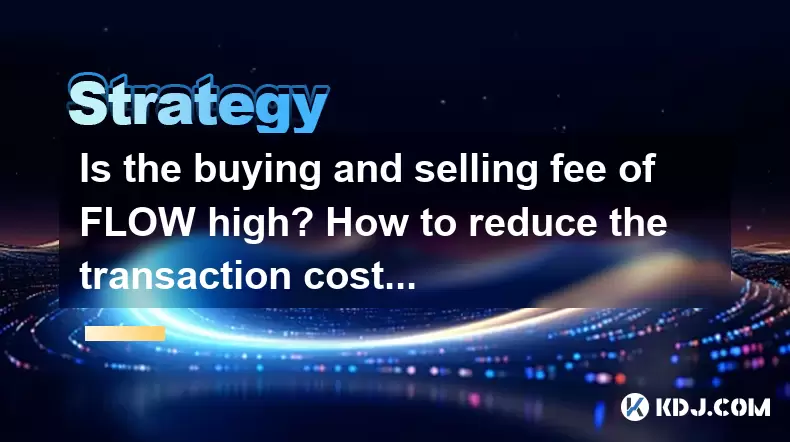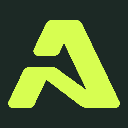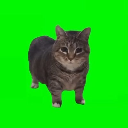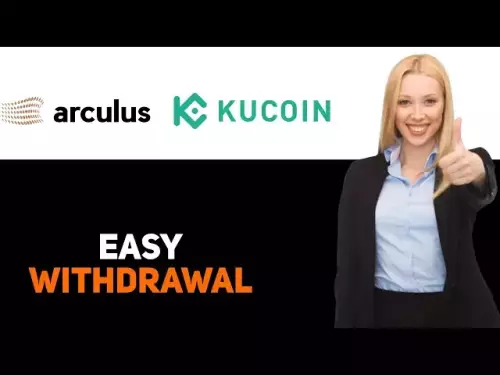-
 bitcoin
bitcoin $114684.631706 USD
-0.87% -
 ethereum
ethereum $4228.677447 USD
1.58% -
 bnb
bnb $1294.880693 USD
-1.16% -
 tether
tether $1.000819 USD
-0.02% -
 xrp
xrp $2.605138 USD
2.79% -
 solana
solana $209.908690 USD
5.89% -
 usd-coin
usd-coin $0.999903 USD
-0.03% -
 dogecoin
dogecoin $0.213423 USD
2.93% -
 tron
tron $0.322721 USD
-0.10% -
 cardano
cardano $0.727247 USD
3.66% -
 hyperliquid
hyperliquid $42.339456 USD
6.05% -
 chainlink
chainlink $19.910811 USD
5.16% -
 ethena-usde
ethena-usde $1.000557 USD
0.00% -
 stellar
stellar $0.349734 USD
2.69% -
 bitcoin-cash
bitcoin-cash $543.848687 USD
-0.21%
Is the buying and selling fee of FLOW high? How to reduce the transaction cost?
FLOW's transaction fees are lower than Ethereum's but can vary; use limit orders, trade during off-peak hours, and choose exchanges with low fees to minimize costs.
May 07, 2025 at 03:35 pm

Is the buying and selling fee of FLOW high? How to reduce the transaction cost?
When it comes to trading cryptocurrencies like FLOW, one of the critical factors that traders consider is the transaction fee. The fee associated with buying and selling FLOW can significantly impact the overall profitability of your trades. In this article, we will delve into the specifics of FLOW's transaction fees and explore various strategies to minimize these costs.
Understanding FLOW Transaction Fees
FLOW, the native cryptocurrency of the Flow blockchain, is designed to support a wide range of applications, including games, digital assets, and decentralized finance (DeFi). The transaction fees on the Flow network are typically lower than those on more congested networks like Ethereum, but they can still vary based on several factors.
The primary components of FLOW transaction fees include:
- Network Fees: These are the fees charged by the Flow network to process transactions. They are usually minimal and are designed to incentivize validators to process transactions efficiently.
- Exchange Fees: When you buy or sell FLOW on a cryptocurrency exchange, the platform will charge a fee for facilitating the transaction. These fees can vary widely depending on the exchange and the type of order you place.
Factors Affecting FLOW Transaction Fees
Several factors can influence the transaction fees you pay when trading FLOW:
- Network Congestion: During periods of high network activity, transaction fees may increase as users compete to have their transactions processed more quickly.
- Type of Transaction: Different types of transactions on the Flow network may have different fee structures. For example, simple transfers might have lower fees than more complex smart contract interactions.
- Exchange Policies: Each cryptocurrency exchange has its own fee structure. Some exchanges offer lower fees for high-volume traders or for using their native tokens.
Comparing FLOW Transaction Fees to Other Cryptocurrencies
To determine if FLOW's transaction fees are high, it's helpful to compare them to other cryptocurrencies. Here's a brief comparison:
- Ethereum (ETH): Ethereum's transaction fees can be significantly higher than FLOW's, especially during peak times. This is due to the high demand for block space on the Ethereum network.
- Bitcoin (BTC): Bitcoin's transaction fees can also be higher than FLOW's, particularly when the network is congested.
- Solana (SOL): Solana is known for its low transaction fees, which are often comparable to or even lower than FLOW's.
Strategies to Reduce FLOW Transaction Fees
There are several strategies you can employ to minimize the transaction costs associated with buying and selling FLOW:
Choose the Right Exchange
Selecting an exchange with competitive fees can significantly reduce your transaction costs. Here are some steps to find the best exchange for trading FLOW:
- Research: Look for exchanges that offer low trading fees for FLOW. Websites like CoinMarketCap and CoinGecko can provide a list of exchanges and their fee structures.
- Compare: Compare the fees of different exchanges. Pay attention to both the maker and taker fees, as these can vary.
- Sign Up: Once you've identified an exchange with favorable fees, sign up for an account. Make sure to complete any necessary verification processes to access the full range of trading options.
Use Limit Orders
Using limit orders instead of market orders can help you save on fees. Here's how to place a limit order:
- Log into Your Exchange Account: Access your trading account on the chosen exchange.
- Navigate to the FLOW Trading Pair: Find the trading pair that includes FLOW (e.g., FLOW/USDT).
- Select Limit Order: Choose the option to place a limit order.
- Set Your Price: Enter the price at which you want to buy or sell FLOW. If the market reaches your specified price, the order will be executed.
- Submit the Order: Review your order details and submit it. The order will remain active until it is filled or canceled.
Limit orders can help you avoid the higher fees associated with market orders, which are executed immediately at the current market price.
Trade During Off-Peak Hours
Trading FLOW during off-peak hours can help you avoid higher network fees caused by congestion. Here's how to identify off-peak hours:
- Monitor Network Activity: Use tools like Flowscan to monitor the activity on the Flow network. Look for times when the number of transactions is lower.
- Schedule Your Trades: Plan your buying and selling activities during these off-peak periods to take advantage of lower fees.
Utilize Exchange Promotions and Discounts
Many exchanges offer promotions and discounts that can help you reduce your trading fees. Here are some ways to take advantage of these offers:
- Referral Programs: Some exchanges offer reduced fees for users who refer new customers. Look for referral programs and share your unique referral link with friends and family.
- Volume Discounts: Exchanges often provide lower fees for high-volume traders. If you trade frequently, you may qualify for these discounts.
- Using Native Tokens: Some exchanges offer reduced fees for users who pay with the platform's native token. For example, if you're trading on Binance, using BNB to pay fees can result in a discount.
Practical Example: Reducing FLOW Transaction Fees
Let's walk through a practical example of how you can apply these strategies to reduce your FLOW transaction fees:
- Choose the Right Exchange: After researching, you decide to use Binance because it offers competitive fees for FLOW trading.
- Use Limit Orders: You log into your Binance account, navigate to the FLOW/USDT trading pair, and place a limit order to buy FLOW at a specific price. This helps you avoid the higher fees associated with market orders.
- Trade During Off-Peak Hours: You monitor the Flow network's activity and notice that transaction volumes are lower during the early morning hours. You schedule your trades during this time to take advantage of lower network fees.
- Utilize Exchange Promotions: You sign up for Binance's referral program and share your link with friends. As a result, you receive a discount on your trading fees.
By following these steps, you can effectively reduce the transaction costs associated with buying and selling FLOW.
Frequently Asked Questions
Q: Can I use a decentralized exchange (DEX) to trade FLOW and reduce fees?A: Yes, you can use a DEX to trade FLOW. DEXs often have lower fees compared to centralized exchanges because they do not have the same overhead costs. However, the liquidity on DEXs can be lower, which might affect the ease of trading and the price you get for your FLOW.
Q: Are there any wallet-specific fees when transacting with FLOW?A: Some wallets may charge a small fee for processing transactions on the Flow network. It's important to check the fee structure of the wallet you are using to understand any additional costs you might incur.
Q: How do gas fees on the Flow network compare to those on Ethereum?A: Gas fees on the Flow network are generally lower than those on Ethereum. This is because Flow is designed to handle high transaction volumes more efficiently, resulting in lower costs for users.
Q: Can I stake FLOW to reduce transaction fees?A: Staking FLOW can provide you with rewards, but it does not directly reduce transaction fees. However, some platforms might offer fee discounts or other benefits to users who stake their tokens, so it's worth exploring these options.
Disclaimer:info@kdj.com
The information provided is not trading advice. kdj.com does not assume any responsibility for any investments made based on the information provided in this article. Cryptocurrencies are highly volatile and it is highly recommended that you invest with caution after thorough research!
If you believe that the content used on this website infringes your copyright, please contact us immediately (info@kdj.com) and we will delete it promptly.
- XRP Price Prediction: Weekend Rollercoaster or Rally?
- 2025-10-12 08:45:16
- Bittensor (TAO): Super Bullish Signals Point to Potential 2x Rally
- 2025-10-11 10:25:12
- Silver Price Correction: Navigating the Dip & Identifying Key SEO Keywords
- 2025-10-11 10:25:12
- Decoding Crypto Trends: Bittensor's Bull Run, Cardano's Dip, and LivLive's Presale Buzz in 'Uptober 2025'
- 2025-10-12 08:45:16
- MoonBull: The Crypto Meme Coin Promising 1000x Gains?
- 2025-10-11 10:30:01
- Crypto Payroll Revolution: Stablecoins, Altcoins, and the Future of Salary Payments
- 2025-10-11 10:30:01
Related knowledge

Practical parameter settings for a Bitcoin multi-timeframe moving average system
Sep 18,2025 at 10:54pm
Optimizing Timeframe Combinations for Bitcoin Trading1. Selecting appropriate timeframes is crucial when building a multi-timeframe moving average sys...

How can I filter out false breakouts in Dogecoin high-frequency trading?
Sep 22,2025 at 01:00am
Understanding False Breakouts in Dogecoin Trading1. A false breakout occurs when Dogecoin's price appears to move beyond a defined support or resistan...

Techniques for identifying tops and bottoms in the Bitcoin on-chain NVT model
Sep 20,2025 at 07:54pm
Understanding the NVT Model in Bitcoin Analysis1. The Network Value to Transactions (NVT) ratio is often described as the 'P/E ratio' of the cryptocur...

What does the surge in open interest in Bitcoincoin futures mean?
Sep 20,2025 at 11:18pm
Understanding the Surge in Dogecoin Futures Open Interest1. A surge in open interest within Dogecoin futures indicates a growing number of active cont...

How can I use the Ethereum USDT premium to gauge market sentiment?
Sep 18,2025 at 11:55pm
Understanding the Ethereum USDT Premium1. The Ethereum USDT premium refers to the price difference between USDT (Tether) traded on Ethereum-based plat...

What should I do if Ethereum staking yields decline?
Sep 20,2025 at 06:18am
Understanding the Causes Behind Declining Ethereum Staking Yields1. The Ethereum network transitioned to a proof-of-stake consensus mechanism with the...

Practical parameter settings for a Bitcoin multi-timeframe moving average system
Sep 18,2025 at 10:54pm
Optimizing Timeframe Combinations for Bitcoin Trading1. Selecting appropriate timeframes is crucial when building a multi-timeframe moving average sys...

How can I filter out false breakouts in Dogecoin high-frequency trading?
Sep 22,2025 at 01:00am
Understanding False Breakouts in Dogecoin Trading1. A false breakout occurs when Dogecoin's price appears to move beyond a defined support or resistan...

Techniques for identifying tops and bottoms in the Bitcoin on-chain NVT model
Sep 20,2025 at 07:54pm
Understanding the NVT Model in Bitcoin Analysis1. The Network Value to Transactions (NVT) ratio is often described as the 'P/E ratio' of the cryptocur...

What does the surge in open interest in Bitcoincoin futures mean?
Sep 20,2025 at 11:18pm
Understanding the Surge in Dogecoin Futures Open Interest1. A surge in open interest within Dogecoin futures indicates a growing number of active cont...

How can I use the Ethereum USDT premium to gauge market sentiment?
Sep 18,2025 at 11:55pm
Understanding the Ethereum USDT Premium1. The Ethereum USDT premium refers to the price difference between USDT (Tether) traded on Ethereum-based plat...

What should I do if Ethereum staking yields decline?
Sep 20,2025 at 06:18am
Understanding the Causes Behind Declining Ethereum Staking Yields1. The Ethereum network transitioned to a proof-of-stake consensus mechanism with the...
See all articles

























![[4K 60fps] Prisma by novichokk (1 Coin) [4K 60fps] Prisma by novichokk (1 Coin)](/uploads/2025/10/14/cryptocurrencies-news/videos/k-fps-prisma-novichokk-coin/68ee49804ba00_image_500_375.webp)
















































